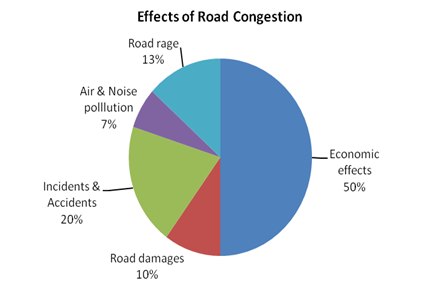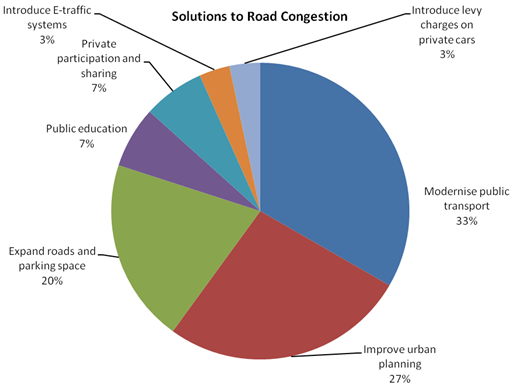Like other cities, Abu Dhabi has heavy traffic jam. Commuters spend several hours stuck in slow-moving jam. Traffic congestion in Abu Dhabi has a number of causes and effects. In the recent past, Abu Dhabi has experienced a population explosion.
Consequently, there are increasing numbers of vehicles on roads as commuters seek to get to their destinations. The rapid rise of middle class and changing lifestyles are also responsible for increasing traffic snarl-up as majorities can now afford their own means of transport (private cars). The report presents ways of resolving traffic congestion in Abu Dhabi using data collected from 30 respondents.
Road congestion occurs as a result of increased use of the road network that results into increased time of travelling. This is the state of Abu Dhabi roads despite the existence of modern roads. Abu Dhabi also requires expansion of its road networks including construction of new ones, and creating ring lanes in the city centre. This shall improve traffic congestion in the city.
Abu Dhabi undertook this approach (DoT, 2012). However, such lanes are insufficient for elimination of the increasing rate of road usages. Abu Dhabi must develop its public transport system as the basic step to eliminating road congestion.
It should ensure enhanced commuter access to public vehicles by opening new roads, and investing in efficient and safe vehicles such as subway lines, speedy trains, and modern public buses (Chaudhry, 2012).
Rapid population growth is also an issue that has led to traffic jam in Abu Dhabi. Road networks should support increasing populations. However, road networks also have their limits to points where they cannot support further expansion or increased number of commuters.
Most of these commuters also live in the city suburbs where they must commute to various destinations. There are also never ending activities within the port that attract all manner of vehicles that cause heavy congestions on the port road.
Abu Dhabi road congestion also results from parking habits of both heavy and light vehicles in traffic areas, entry and exit of commercial vehicles during rush hours (Abudhabi-Expat-Life, 2011).
Levels of household earning have increased tremendously. As a result, majorities can afford commuting using different modes. Thus, a number of such travellers prefer their personal cars. Such people do not use public means of transportation, but their private cars.
This increases the demand for road networks as many cars need same routes. Most people also blame traffic congestions on poor urban planning. There are sprouting city settlements away from the central city to cater for the increasing populations.
Commuters spend most of their time in traffic jams. This results into frustration among road users and lost opportunities and productive hours. Time spent waiting in road congestions affects income levels of people and economy as a whole.
Economists view lost time in terms of monetary value and amount of fuel consumed in traffic jams. Traffic congestions also affect economic productivity of Abu Dhabi. Commuters experience hiked prices due to long hours in traffic jams.
Further, people, firms, and business enterprises experience losses due to delays as majorities spend productivities hours on the road. As a result, there are persistent loss of opportunities, increasing costs of running business, pollution and rates of accident.
Governments have squarely based such arguments on traffic jam alone. Thus, traffic jam has prompted authorities to take immediate action in order to avoid unwanted consequences of road congestion on the economy. In some case, using private vehicles as modes of transport is no longer viable due charges and taxes that governments levy on them.
People have resorted to public transport. Such severe economic consequences have forced most authorities to upgrade their urban transport systems to the international standards, expand train systems, construct freeways, introduce transport management systems, and promote the use of public transportation systems.
Traffic jam is also a major cause of road carnage and incidents. This argument emanate from the fact that an increase in the number of vehicles will enhance rates of road carnage. Most data indicate that cases of road accidents and incidents are numerous during peak hours (Downs, 2004).
Still, some drivers experience fatigue or lack of concentration due to long hours in jams and working hours. Such factors have enhanced cases of road accidents and incidents.
We may attribute the main cause of growing rates of road accidents to increasing numbers of vehicles on the roads. We must acknowledge that road accidents and incidents are also responsible for road congestion. This is an issue of cause and effect relations in road usages.
Traffic jam results into decreased lifetime of the road surface. This is because roads lose their layers and elasticity that can support the weight of different types of vehicles using them. Vehicles cause high deflection of the road surfaces when they are not moving, moving slowly, or when they are many.
As time goes, the road surface losses its elasticity as top layers become lesser effective. This results into several maintenance practices than planned. In addition, areas with heavy traffic experience early drops in quality of the road than expected.
There are high costs of vehicles maintenance in places of heavy traffic. Road congestion is not good for high speed modern vehicles. For instance, sudden acceleration and brakes have negative effects on the vehicle engines. Vehicle engines function even in traffic despite the fact that no movements take place.
This results into frequency of servicing beyond manufacturers’ recommendations. Maintenance costs also account for wear and tear of spare parts, such as brakes and clutch as their functions increase with increased usages.
Psychologists believe that among the main causes of road rage occur due to frustrations caused through road congestions. People of outbursts personalities and tendencies take such rage to other road users so as to vent their anger. They have peculiar habits such as changing lanes, close following, or sudden brakes.
In addition to air pollution, there is also noise pollution that causes concerns among environmentalists. There are exhaust emissions that are responsible for the rising quantity of greenhouse gases in the atmosphere.
The issue of global warming has shifted focus from main industries to transportation system as significant contributors in emissions of greenhouse gases through combustion of fuels. Consequently, vehicles manufacturers improve technology in modern, hybrid vehicles to reduce emission of carbon dioxide and enhance fuel efficiency.
The main sources of noise pollution mainly come from hooting, roaring vehicles engines, and radio and music systems in vehicles. However, slow movements of vehicles increase the level of noise as road congestion tends to concentrate such noise pollution in busy roads.
Description of Idea
Causes
There are many factors responsible for traffic jam in Abu Dhabi. Time of road use is the same among most commuters. Most road users share the same time of travelling. These schedules result into high demands of road usages at certain times.
Effects
Traffic jam has severe effects in terms of economic losses, carnage, rage, pollution, and maintenance costs of vehicles.
Audience
Urban planners and developers will find this report useful.
Scholars interested in studying causes, effects and elimination of road congestions.
This report is also relevant to road users.
Survey Information
Participants
The researchers used 30 participants from random selection process.
Data Collection
The researchers designed survey question for data collection.
Area of Study
Abu Dhabi
Results
Abu Dhabi also lacks reliable public transport systems because of poor internal mode of transport. Most commuters rely on taxi cabs.
People believe that there is no need of driving private cars. Abu Dhabi should borrow from the Dubai Metro and public transport system. This also means constructing many bridges to link areas like Meshaireb Island, and Zayed Street.
There should be a coordinated effort among stakeholders such as municipality, planning department, and public works so as to identify possible solutions for intersections responsible for jams.
Installation of traffic control lights in main streets to control traffic. There should be a widespread public education on road usages.


Recommendations
Abu Dhabi should perform a radical change in its entire system of public transport. Abu Dhabi must encourage all commuters to use public transport. However, they should be timely services, reliable means, and safe.
The government should also encourage participation of private sector in the provision of transport services in specified routes and periods (UAE Interact, 2012).
Abu Dhabi road congestion occurs due to poor planning (Santos, Behrendt and Teytelboym, 2010).
Government should construct access and feeder roads (National Consultative Council, 2002).
Commuters who use same routes can have ride sharing initiatives. It is suitable for large institutions such as schools, universities, public institutions, and other organisation.
Police should also provide traffic education among the public.
There should also be a comprehensive and continuous study on the state of Abu Dhabi busiest roads.
There are also calls to introduce E-traffic systems for managing traffic.
The government can also introduce charges and taxes to combat road congestion.
There is also a need among local authorities to increase the number of available parking spaces.
References
Abudhabi-Expat-Life. (2011). Is Abu Dhabi traffic turning into a nightmare? Web.
Chaudhry, A. G. (2012). Evolution of the transportation system in Dubai. Network Industries Quarterly, 14(1), 7-1.
DoT. (2012). Road Projects. Web.
Downs, A. (2004). Still Stuck in Traffic: Coping with Peak-Hour Traffic Congestion. Washington, D.C.: Brookings Institution Press.
National Consultative Council. (2002). Developing the traffic movement and treating the traffic jam problem in Abu Dhabi. Abu Dhabi: National Consultative Council.
Santos, G., Behrendt, H. and Teytelboym, A. (2010). Part II: Policy instruments for sustainable road transport. Research in Transportation Economics, 28, 46-91.
UAE Interact. (2012). DPE Weekly Report: Traffic congestion in Abu Dhabi city. Web.
Appendix
Is Abu Dhabi traffic turning into a nightmare?
